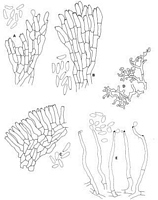|
 Xylaria schreuderiana Xylaria schreuderiana
BiostatusPresent in region - Indigenous. Non endemic
Images (click to enlarge)
Caption: Fig. 12 Xylaria anamorphs A, X. schreuderiana (from culture, PDD 43183). B, C, D, X.
apiculata (B: PDD 44271 from culture, C, PDD 44322 from nature, D, Sterile hairs
formed in cultures, PDD 44322). E, X. palmicola (PD | 
Caption: Fig. 11 Xylaria schreuderiana A, Stromata (PDD 30236). B, Stromatal surface (PDD
30236). C, Ascal ring (Melzer's reagent, PDD 41965). D, Ascospores (Melzer's reagent, PDD
41965). E, Colonies on OA (PDD 43183) (Lines A = 1 cm; C, D = 10 µm). |
Description: Stromata: Stromata spherical, or upright (taller than broad); stipitate; 1-4 mm tall; 1-2 mm diam.; perithecia conspicuous; ostioles lower than or more or less equal to stromatal surface; stromatal surface with peeling or flaking scales; dark brown (brown vinaceous), or blackish; KOH-extractable pigments lacking; tissue below perithecia conspicuous, essentially homogeneous, white.
Perithecia: Perithecia more or less globose; 0.3-0.4 mm diam.
Asci: Stipe short with spores filling about two-thirds of ascus; amyloid ring broader than high, or higher than broad.
Ascospores: Ascospores 18-21 µm long; 7-9 µm wide; very pale brown; 0-septate; in side view inequilateral, flattened on one side, not curved; in face view elliptic; ends narrowly rounded. Germ slit straight, spore-length; on flattened side of spore. Perispore indehiscent in 10% KOH.
Article: Rogers, J.D.; Samuels, G.J. (1987) [1986]. Ascomycetes of New Zealand 8. Xylaria. New Zealand Journal of Botany 24(4): 615-650 (http://www.rsnz.org/publish/abstracts.php).
Description: Stromata gregarious, sessile, or stalked, at first conidial, fertile portion subglobose, 1-2 mm
diam., often with an apiculus, containing only a few perithecia or less frequently fertile
portion with more perithecia and then subcylindrical; with brown tissue splitting
longitudinally away from the apiculus and stromal surface appearing rugose; with stiff,
erect, brown, setose hyphae arising from all over stroma, or hairs not evident; perithecial
outlines obvious; perithecia 300-400 µm diam., openings not evident; internal tissue of
stroma white, solid; stipe sharply delimited from fertile portion, most stipes 0.5-1.0 mm
long and stromata appearing sessile, less frequently stipes up to 10 mm long x 0.5 mm
diam. and densely setose. Asci 160-200 µm total length x 7-9(-10) µm, sporiferous part
(110-)115-135(-160) µm, cylindrical, apical ring J+, wedge-shaped, 3-4 µm high x: 3-4 µm
wide; 8-spored, ascospores uniseriate with overlapping ends. Ascospores (15-)18-21(-26) x
(6-)7-9(-11) µm; inequilateral with one side flat and one side curved, elliptic in top view;
brown, transparent; slit full length or slightly less than full length, 13-15(-18) µm long,
parallel to long axis of ascospore.
CHARACTERISTICS OF CULTURES: Colonies grown 2 weeks at 20°C in diffuse
daylight on CMD 5-6 cm diam., flat, white, transparent with scant aerial mycelium, colony
margin deeply dissected. On OA colonies >, 9 cm diam., densely cottony, white. Within
one month on OA colony surface with a black stromatic overlay. Stromatic structures arising in
ill-defined concentric rings, 2-3 mm long, dendroidally branched, black with white
tips; with stiff brown hairs arising from the surface; most remaining sterile but with conidia
forming on a few. Conidiophores arising over the entire surface of the stroma, branching
irregularly and forming a loose but uniform palisade; conidiogenous cells cylindrical, 7-13
x c. 3 µm; conidia borne apically, leaving a refractive, 1.0-1.5 µm diam. frilled scar after
dehiscence. Conidia (4.5-)5.0-6.5(-8.0) x 1.5-2.0 µm, oblong to clavate and sometimes
asymmetric with a faint apical beak or hook; colourless, smooth; each with a flat,
protuberant, c. 1 µm wide, refractive basal abscission scar.
Habitat: HABITAT: On wood of dicotyledonous trees, and woody stems of Solanum sp. and
Ripogonum scandens (Smilacaeae).
Notes: Xylaria schreuderianais a relatively common species in New Zealand It is
related to X. apiculata, X. arbuscula, and X. zealandica. Dennis (1956) believed X.
schreuderiana to be only a kretzschmariold state of X. apiculata, but our field and cultural
data indicate that it is best maintained as a separate species. We have examined authentic (?
type) material of X. schreuderiana [South Africa, van der Bijl no. 1365, Nov. 1932 (K)].
|